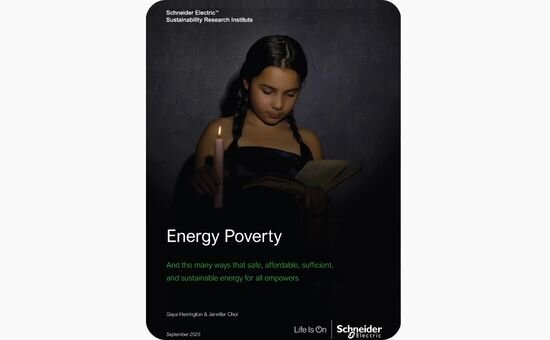Energy poverty
- By Gaya Herrington & Jennifer Choi
- 16 Sep 2025
- 5 min
"Energy poverty touches on almost every social, environmental, technological, political, and economic aspect you can imagine, from AI to indigenous rights, from governance structures to planetary boundaries, from tariff wars to actual wars." - Gaya Herrington, VP Sustainability Research, Schneider Electric
Depending on how it’s measured, between 666 million and 3.3 billion people lack sufficient, reliable, or affordable energy to live, learn, and work with dignity. Behind the statistics are daily trade-offs: studying after dark, heating a home, powering a clinic, cooking without toxic smoke.
Energy shows up differently across economies:
- AccessFor low income countries, millions remain off-grid or under-served.
- AffordabilityFor high-income countries, energy exists, but prices force impossible choices.
- ReliabilityFor many middle-income countries, grids falter when people need them most.
The World Energy Council frames this challenge through their Energy Trilemma Index, visualizing energy poverty as a delicate balance between three competing priorities: security, equity, and environmental sustainability.
Source: World Energy Council
Subsidies may boost affordability but encourage waste, while rapid renewable build-out improves sustainability but can pressure prices without careful design. The policy goal is to improve all three corners with targeted sequencing and protections for vulnerable households.
Other factors (climate shocks, geopolitics, and inequality) actually amplify energy hardship:
- Climate change raises demand (cooling/heating) while stressing infrastructure.
- Geopolitics turns molecules and minerals into leverage.
- Inequality determines who can benefit from new technologies. As an example, women and girls often bear the heaviest burdens — from time lost gathering fuel to higher exposure to indoor air pollution, making gender-inclusive design essential.
A shift to distributed energy, including mini-grids, microgrids, community solar, and storage, can compress timelines, build resilience, and keep value local when paired with inclusive governance:
- Own locally, benefit locally. Community ownership and cooperatives increase trust, prioritize clinics and schools, and keep profits in-community.
- Design for co-benefits. When you count avoided health costs, outage losses, and environmental damage, projects pencil out faster.
- Build agency, not just assets. Training, maintenance, and local decision rights turn electrons into durable economic gains.
This approach leads to “energy democracy”, which describes communities that both generate and use power — trading excess, shaping rules, and aligning systems with local values. Communities become “prosumers”, both producers and consumers of energy, a key player in the new energy landscape, enabling better alignment to their needs. Smart grids, fair tariffs, and transparent data empower households while protecting privacy and equity. The outcome is more than reliable power: it’s dignity, participation, and opportunity.
Policies have the power to shape the future, by aligning incentives with outcomes.
Enable community energy
Clear legal frameworks, streamlined interconnection, and fair compensation for exports.
Target protection
Lifeline tariffs and direct support to shield vulnerable users during transitions.
Invest in reliability
Grid upgrades that support bi-directional flows and storage, not just capacity additions.
Measure what matters
Health, education, and productivity — not only kilowatt-hours and levelized costs.
Champion sufficiency
Encourage efficient use so universal access can be achieved within planetary limits.
Where distributed systems and inclusive governance meet, whole local economies change: jobs emerge, youth out-migration slows, and women take on leadership roles in energy cooperatives. These changes are visible today across communities in Africa, Asia, and Latin America, but the remaining gap is coordination.
Download the full report to explore methods, scenarios, and policy pathways to end energy poverty, while advancing security, equity, and sustainability.

Latest from the Sustainability Research Institute
Time to power: A generational cycle of modernization in the US
Introducing the integrated Net Present Value framework
Original insights on the decarbonization potential of Brazil through innovation
Demand-pull policy framework for emission intensive industries


